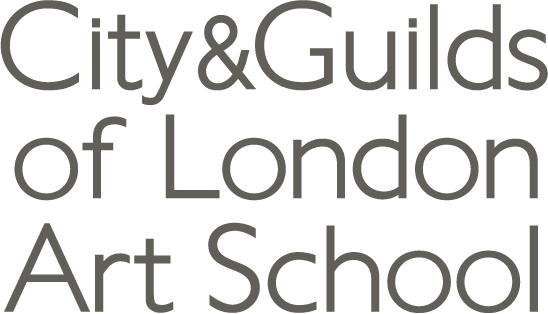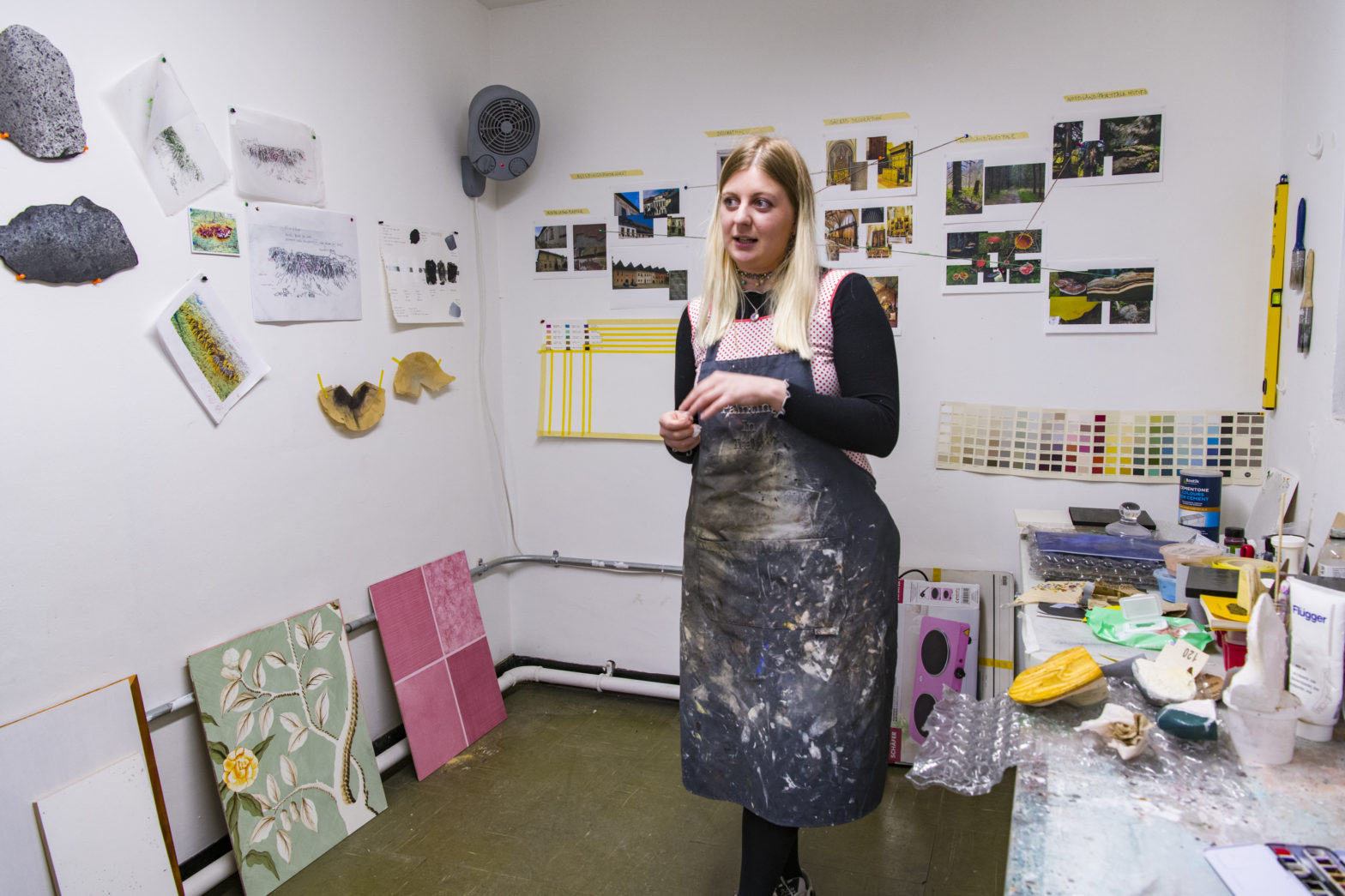www.pollybennett.com
instagram.com/polben.art
BA Fine Art alumna and current Painter-Stainers Decorative Surfaces fellow Polly Bennett discusses her interests in environmentalism, amateur scientific enquiry, memory, her reflections on rural environments, and her work with pigment.
Polly started making her own pigments during the second year of her Fine Art degree at the Art School, following a research trip she took to Slovenia where she came across a red, brick-coloured rock.
“I’ve always collected things; I have collected rocks since I can remember, since I was a child. I like little things; they hold memories for me. It was just a natural progression for me to use the things that I collect in the artworks to represent the places they come from, to collaborate with the earth itself, the landscape.”

Pigments in Polly’s studio at the Art School 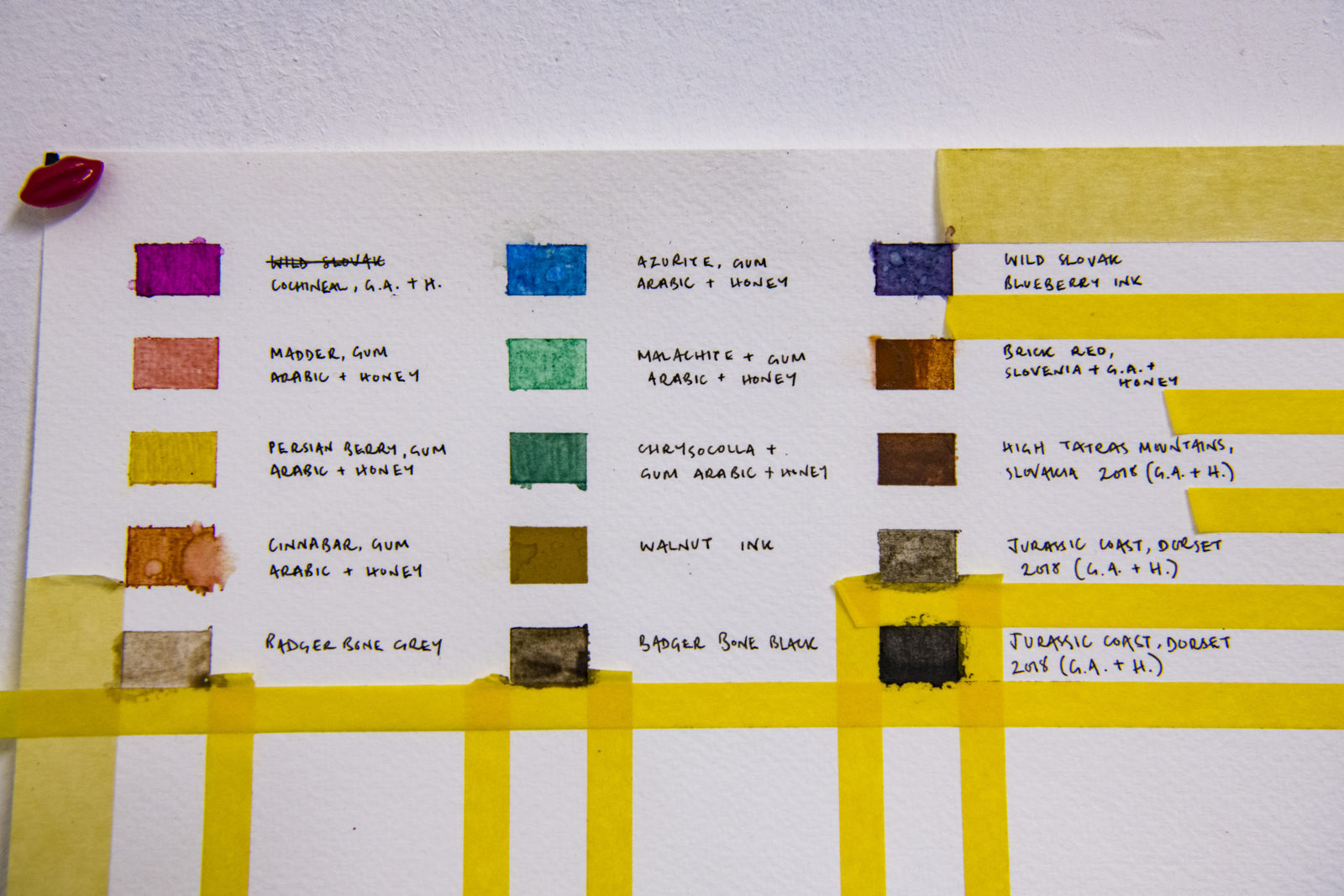
Experiments with pigments and binders
The next experiments with pigment making came in 2018 with her degree show work, this time inspired by a research trip to Iceland.
“I was looking at the geology and the colours of Iceland, deconstructing the landscape down to its basic elements. I ended up almost recreating little versions of these landscapes within domes. They were large variations on a snow globe, consisting of different coloured snowcrete forms representing the geology of Iceland – basalt, rhyolite, iron and so on. The colours of the water inside the globes came from watercolour soakings which depicted the landscapes. My work is always based on my memory, that’s quite important. It’s never the real thing, and it’s always going to be slightly uncanny because it’s based on my memories. In the domes, bacteria grow because the water is stagnant. The water also slowly decreases because it soaks into the snowcrete, which in turn looks at environmentalism and what we’re doing to places like Iceland and Antarctica in terms of the ice melting.”
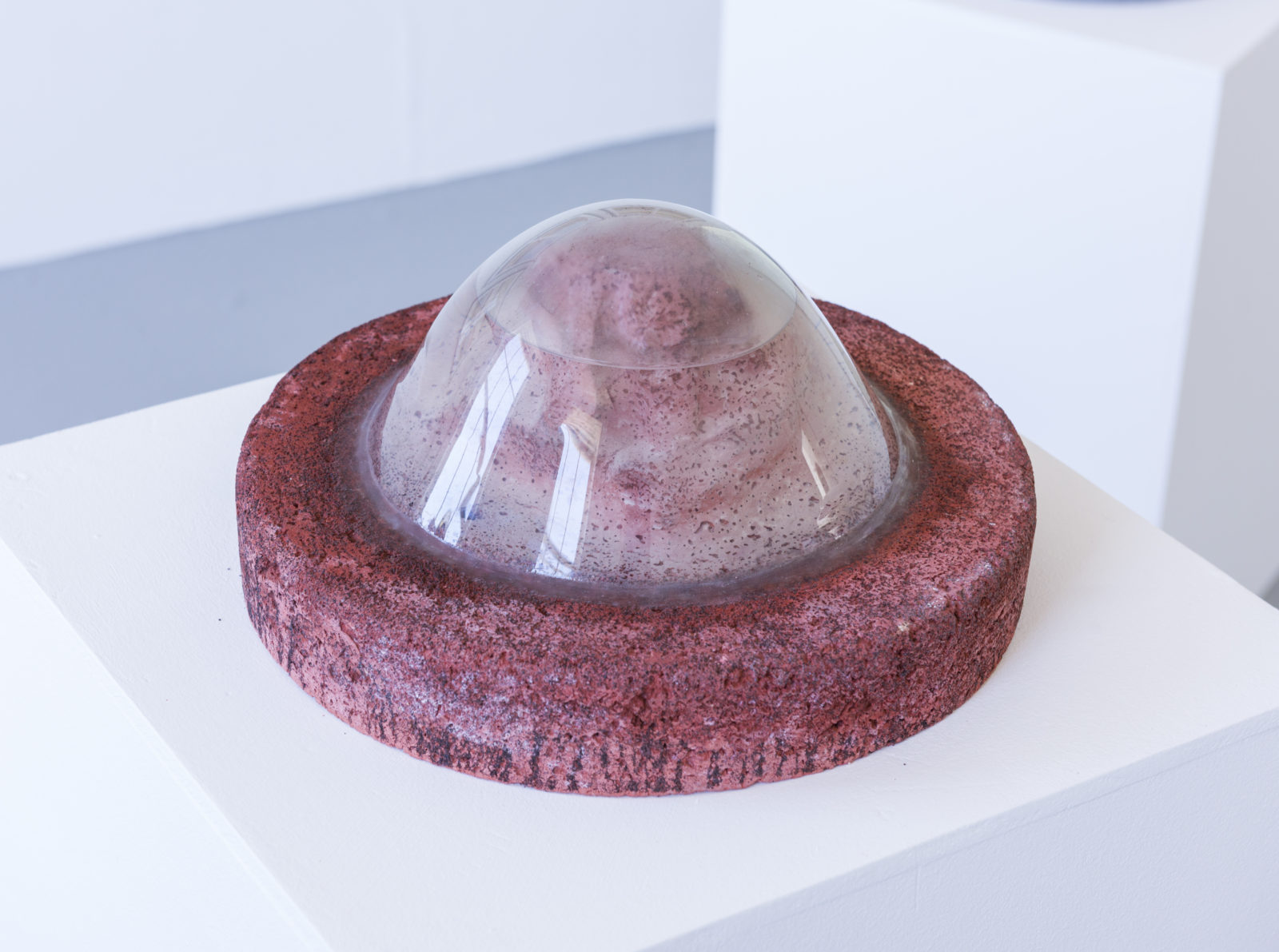
One of the snowcrete domes from Polly’s degree show 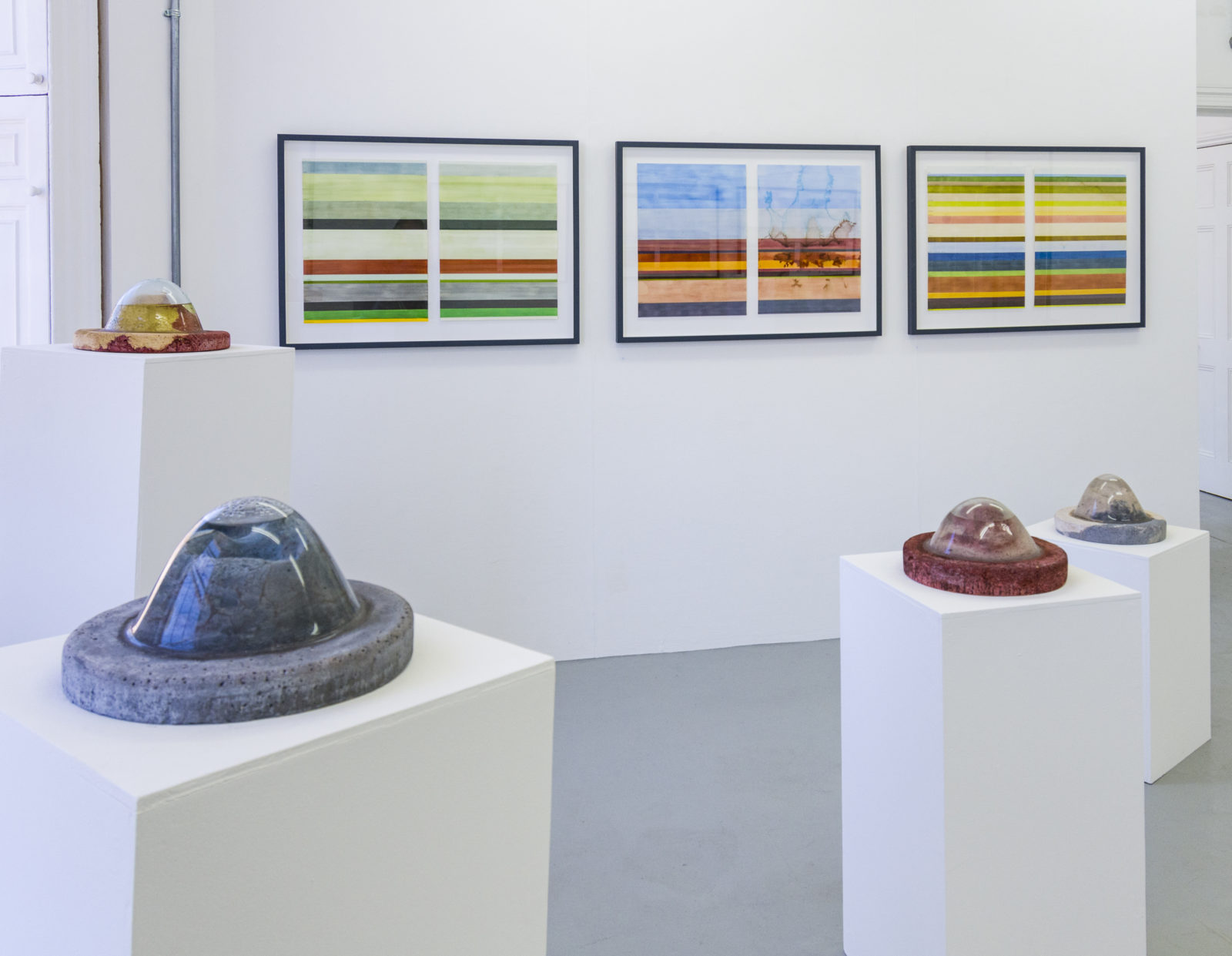
Installation shot of the degree show
These living, changing miniature landscapes demonstrate Polly’s emerging interest in using pigment. Here, pigments stand in for the raw elements of a particular place; their colours, even when changing over long periods of time, recall her own memories of being in that place. She is interested in both collecting and using the samples that she finds:
“When I went to Iceland, I collected a lot of things – volcanic sand and rock – but I didn’t make them into pigments because I like them in the collection of the other things that I found. I guess it depends on the context as well, on why I’m looking for things, and where I find them. I don’t necessarily go out looking for specific things. Now that I use my own pigments, I probably have a heightened engagement with where I’m walking, looking specifically for specific colours and different rocks that kind of spring out to me. Mostly though it’s intuitive. If I see something that grabs my eye, I’m going to pick it up, and that’s anywhere, in London, back home in Kent, abroad.”
Polly has continued to work with pigments as Decorative Surfaces fellow at the Art School. In September 2018 she took course with David Cranswick on ‘The Alchemy of Colour’, where she learnt how to extract pigments from earth, rocks, roots and berries. These pigments have been used in her current body of work, recreating a version of the Slovakian High Tatras mountain range where she went bear trekking, including carved, painted and gilded wooden fungi.
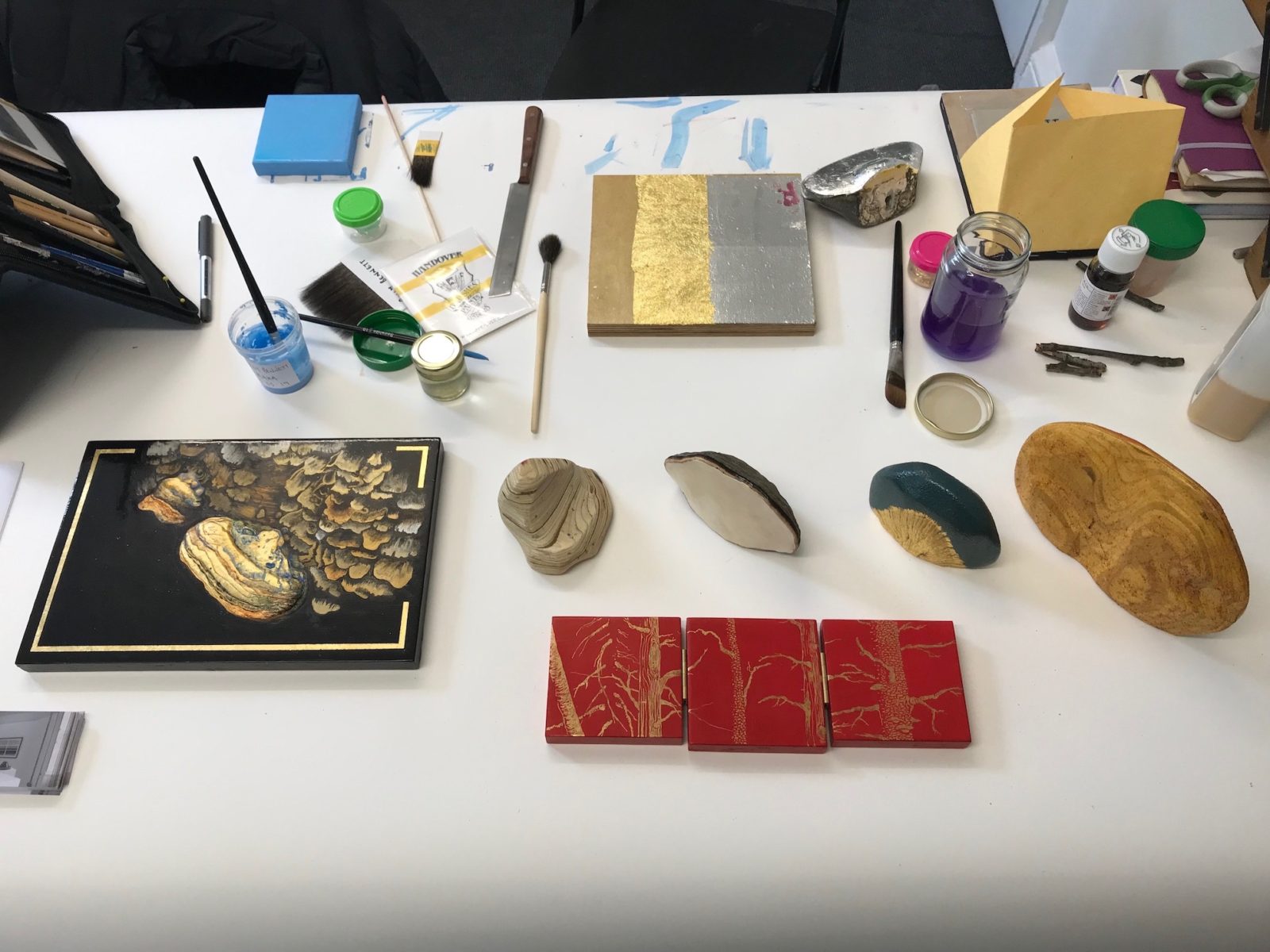
“I started off with these pigments [made during the Alchemy course] – lapis lazuli, azurite, cinnabar, chrysocolla. Those are the more expensive pigments – you’d be very lucky to just find them. Lapis lazuli is worth its weight in gold.
The fungi are from Slovakia – red banded bracket fungi. Rather that coming up from the ground they grow on dead tree trunks, they stick out in kind of like an oval, and look a bit like oyster shells. They grow quite far out, and they really do take over. They’re quite big, some of them were the size of plates. They’re really amazing colours, kind of rainbow colours. The individual layers that grow on top of each other come out in different colours. They are very common, so they’re not native just to Slovakia, but they tend to live off spruce trees, and they were just everywhere when we were in Slovakia, all over the woodlands by the High Tatras. They are really topographical as well. When I made the wooden fungi I used plywood, and again the lines and layers in the plywood look like contour lines, which reminded me of the mountains in the High Tatras themselves. “
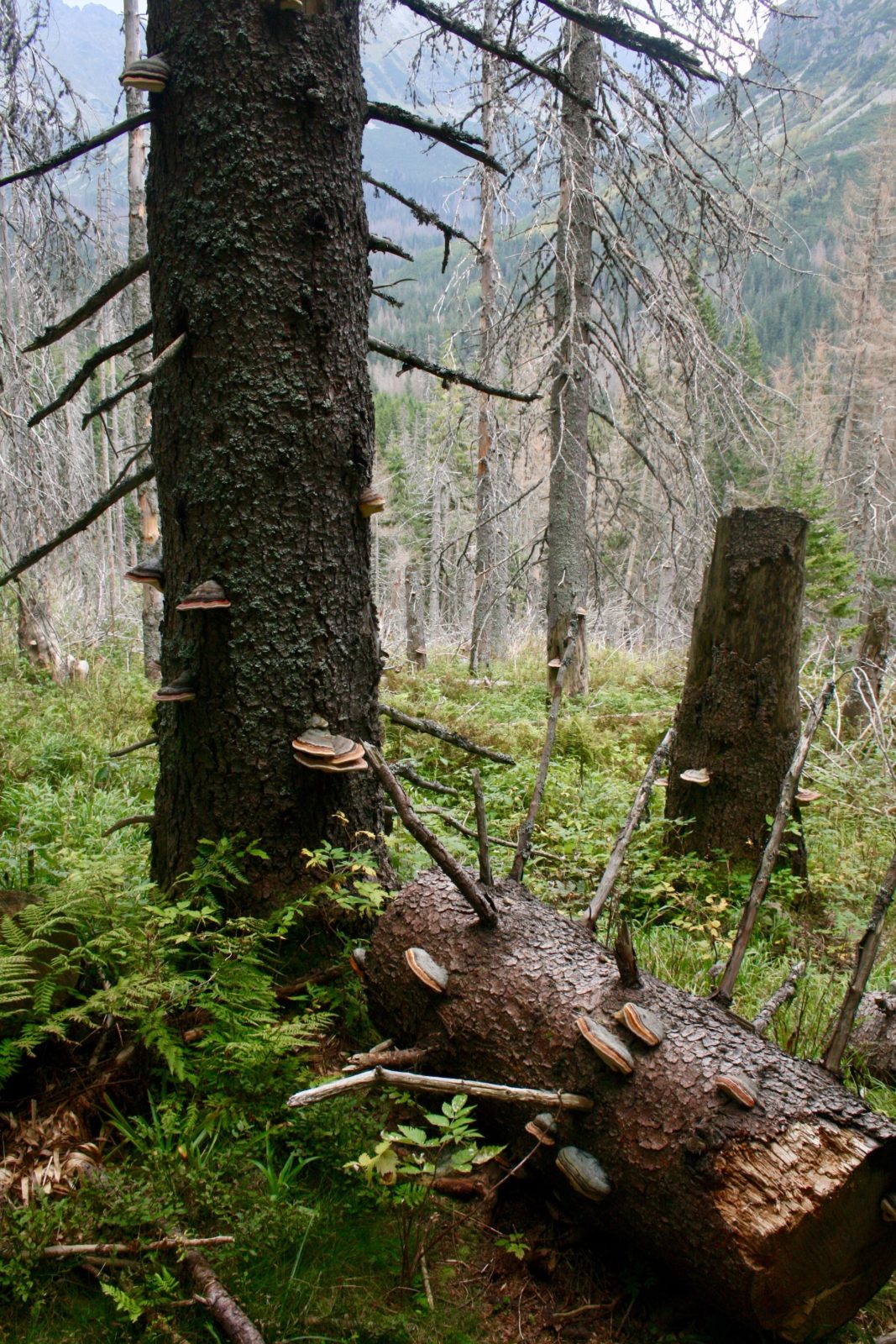
Photos from Polly’s trip to the High Tatras 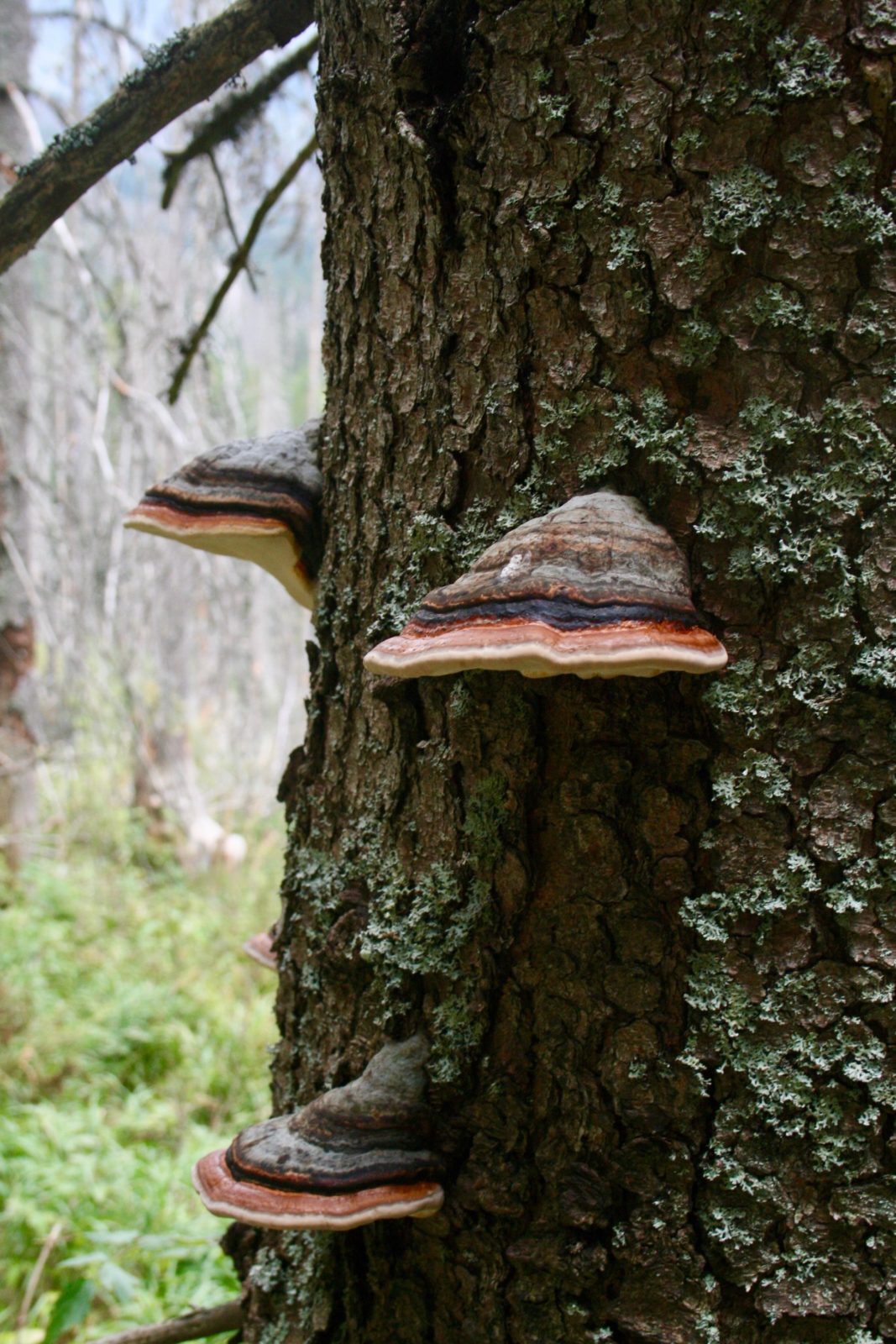
Red banded bracket fungi in the Slovakian woods
“My fungi all start out as wood, layers of MDF and plywood glued together and sanded down to make different shapes. Then I use different applications, whether its shellac, or my pigments; a blue pigment that I found in Malvern, near Worcester, the red one is cinnabar, the yellow one is Persian berry.
I tried out different ways of mullering, so some pigments I would muller more, and some I would muller less. Mullering is when you grind the pigment into the binder (glaze or shellac). With the glaze ones I didn’t muller that much – I wanted to leave a speckled, bumpy finish.
Some of the wooden fungi are particularly nice with the lines of ply, so I won’t be painting over them all, maybe just shellac it with a clear shellac so that it looks almost like resin or plastic. But also I wanted to use the ply specifically to mimic the lines in the fungi and then use different decorative applications to emphasise the colours and the shapes.”
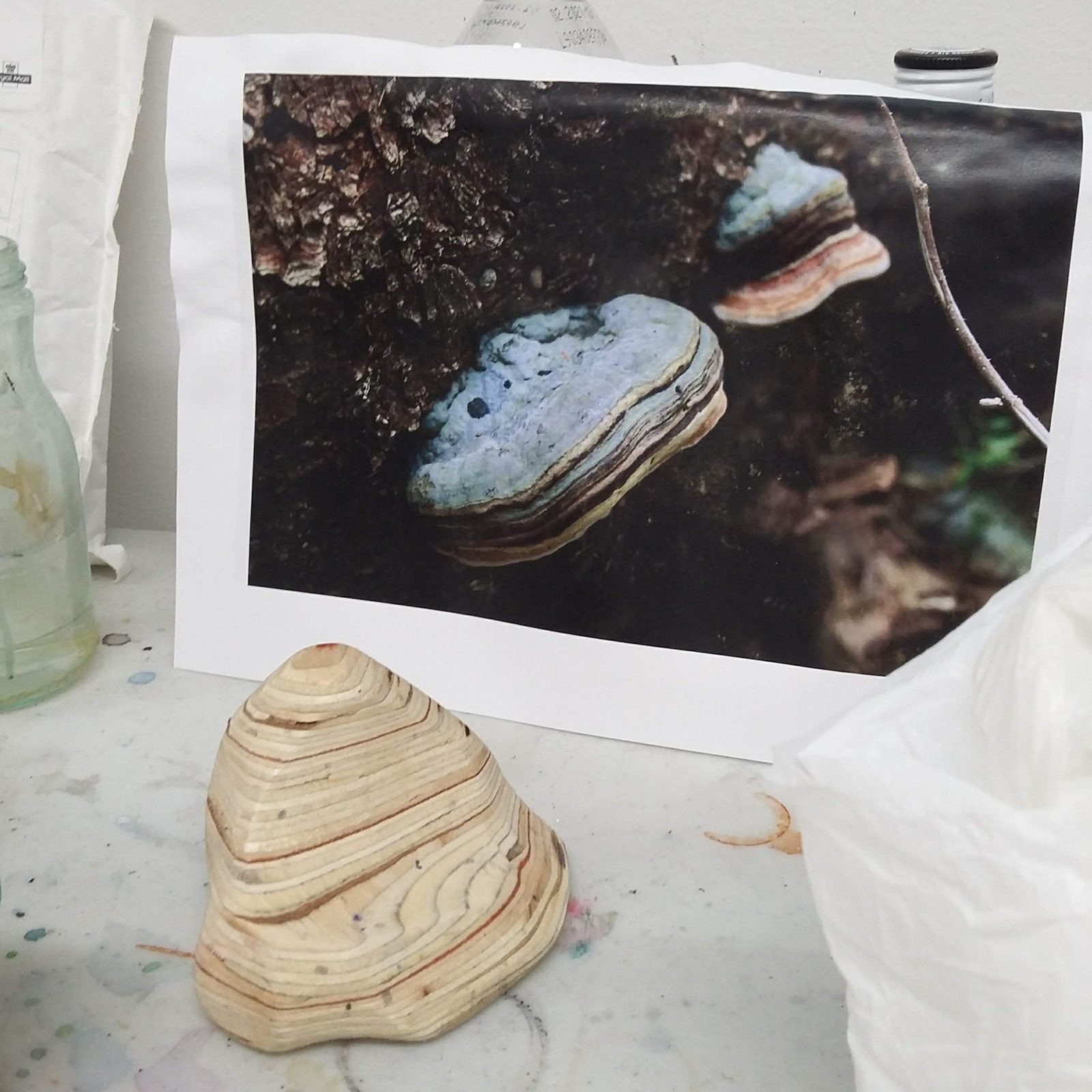
Carved plywood fungus 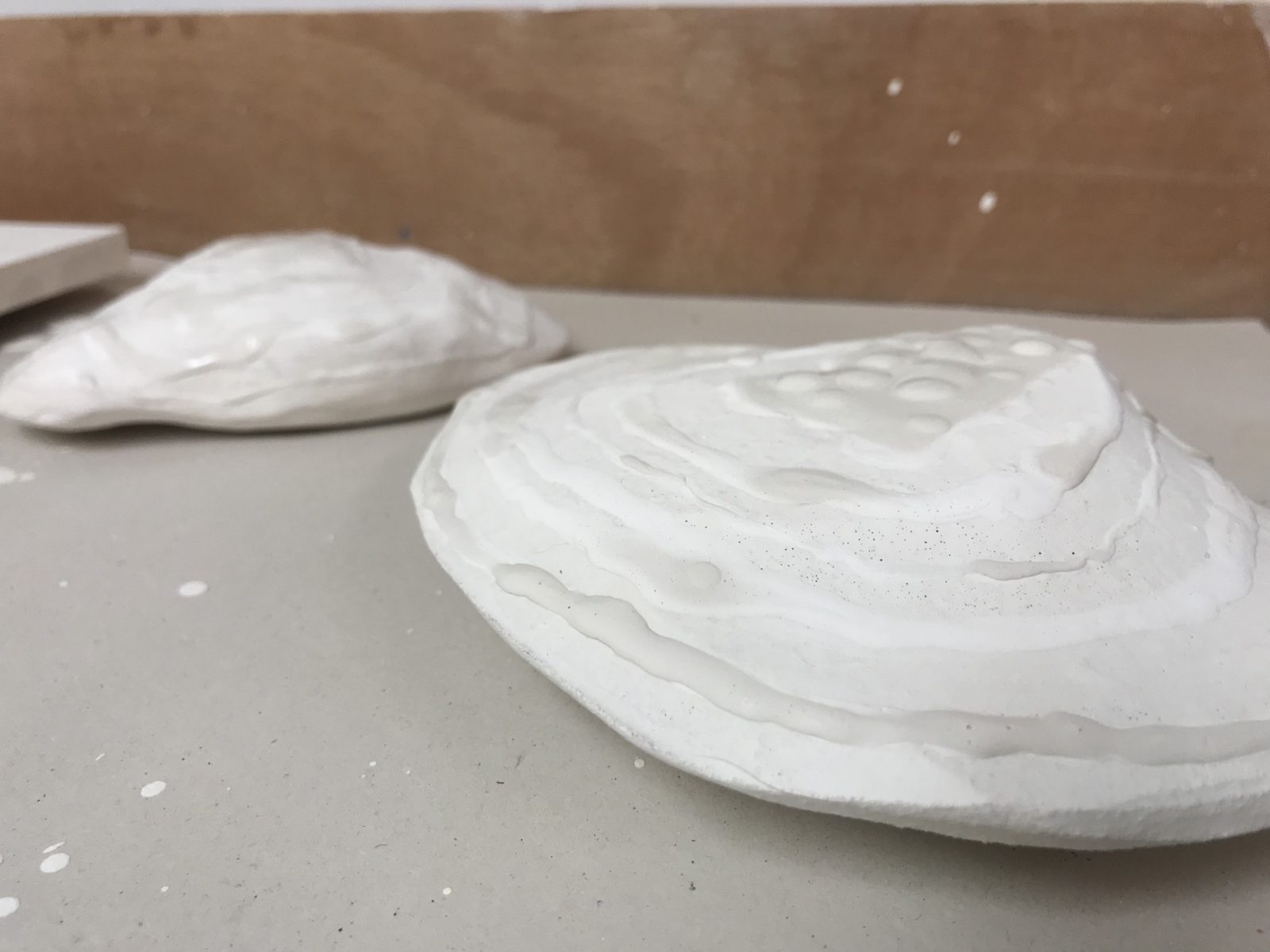
Some gessoed fungi 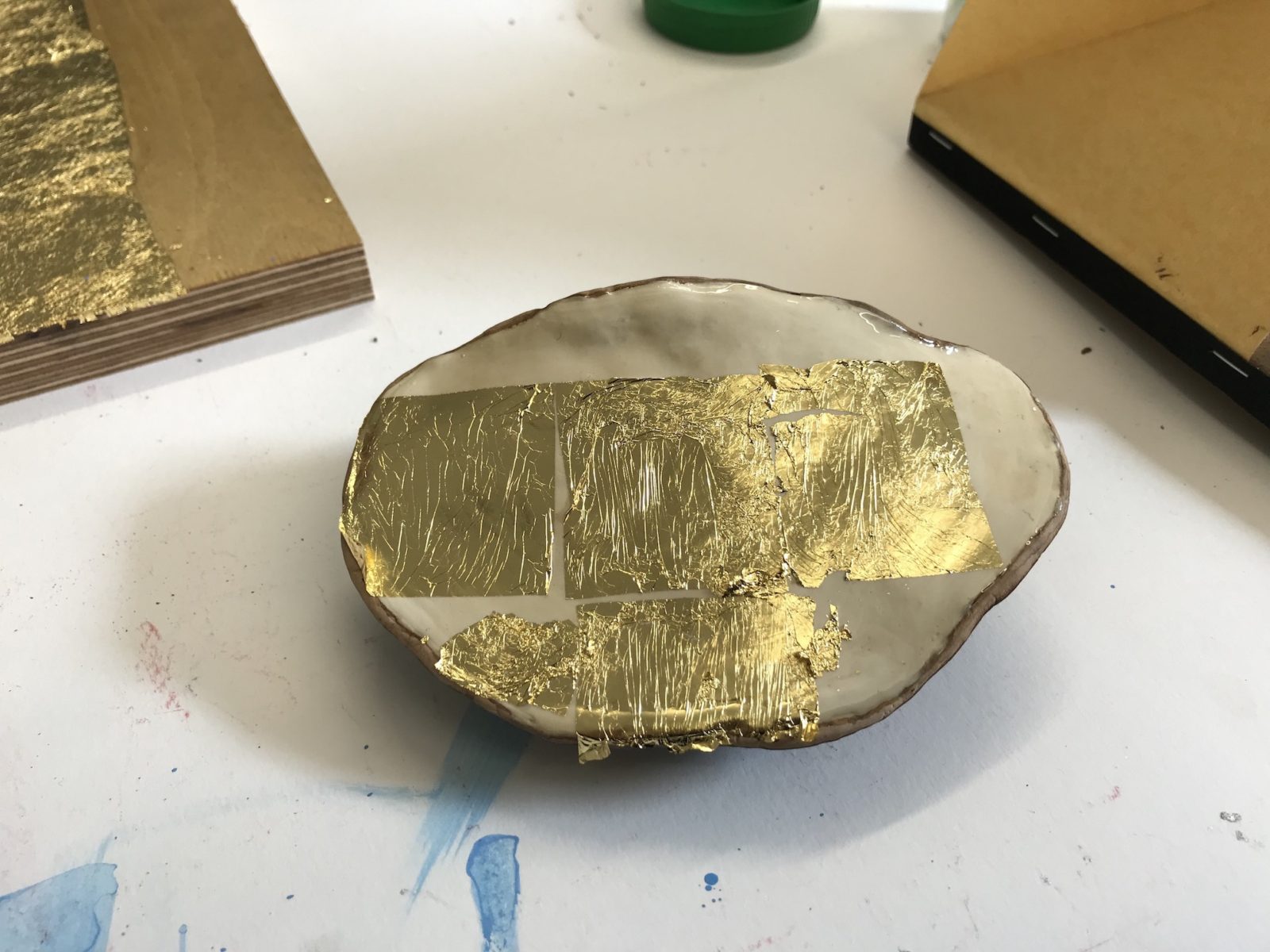
Gilding a fungus
Another element of this body of work, which will be on show at the MA degree show in September 2019, will be woodblock wallpaper, creating an immersive forest for the fungi to live in.
“The image of the wallpaper will be the woodlands below the High Tatras: life-size trees which the fungus can be imposed on to. It’s going to be made from woodblock, and a continuous image of the tree trunk, so you’ll never see the bottom or the top of the tree. I want the wallpaper to be quite dense because the forests were very dense and thick. I went to the Munch exhibition at the British Museum. He used woodblocks a lot. He kept the grain of the wood in his blocks, and would ink up the grain, making it part of the print, which I found quite interesting.
Gilding and japanning are other skills that I am using on the fungi. What I picked up from Slovakia was how magical it is; you’re walking through these really dense forests, the whole ground is carpeted with this really dense green moss, you have these multi-coloured fungi, you have bear posts, which are basically tree trunks where the bears leave their markings by standing on their hind legs and gnaw away at the bark and all the sap comes out, so you have this glistening, golden sap. It was all quite magical, and for me the aesthetics of gilding and japanning lend themselves quite nicely to that atmosphere, especially when the fungi are so colourful. It just suited it quite well. I collected two bear hairs from one the bear posts, but they’re in my scrapbook.”

Polly’s scrapbooks, as much a part of her practice as the finished works, are rich, detailed logbooks of her travels and subsequent experimentations.
“I’ve always liked the idea that research is very much the work as well, because it’s how you’ve got to a destination. If they’ve got you to somewhere, then they’re part of it. Plus, I think it’s kind of a romantic idea, the traveller’s notebook.
Because I’ve been able to make as many fungi as I wanted, it has been a great way to experiment. There are multiple objects so I can do loads of different things to them. Some of them I’ve burned, which was quite fun. When fungi die, they go black, kind of look woody but also like they’ve been sat on the fire.”
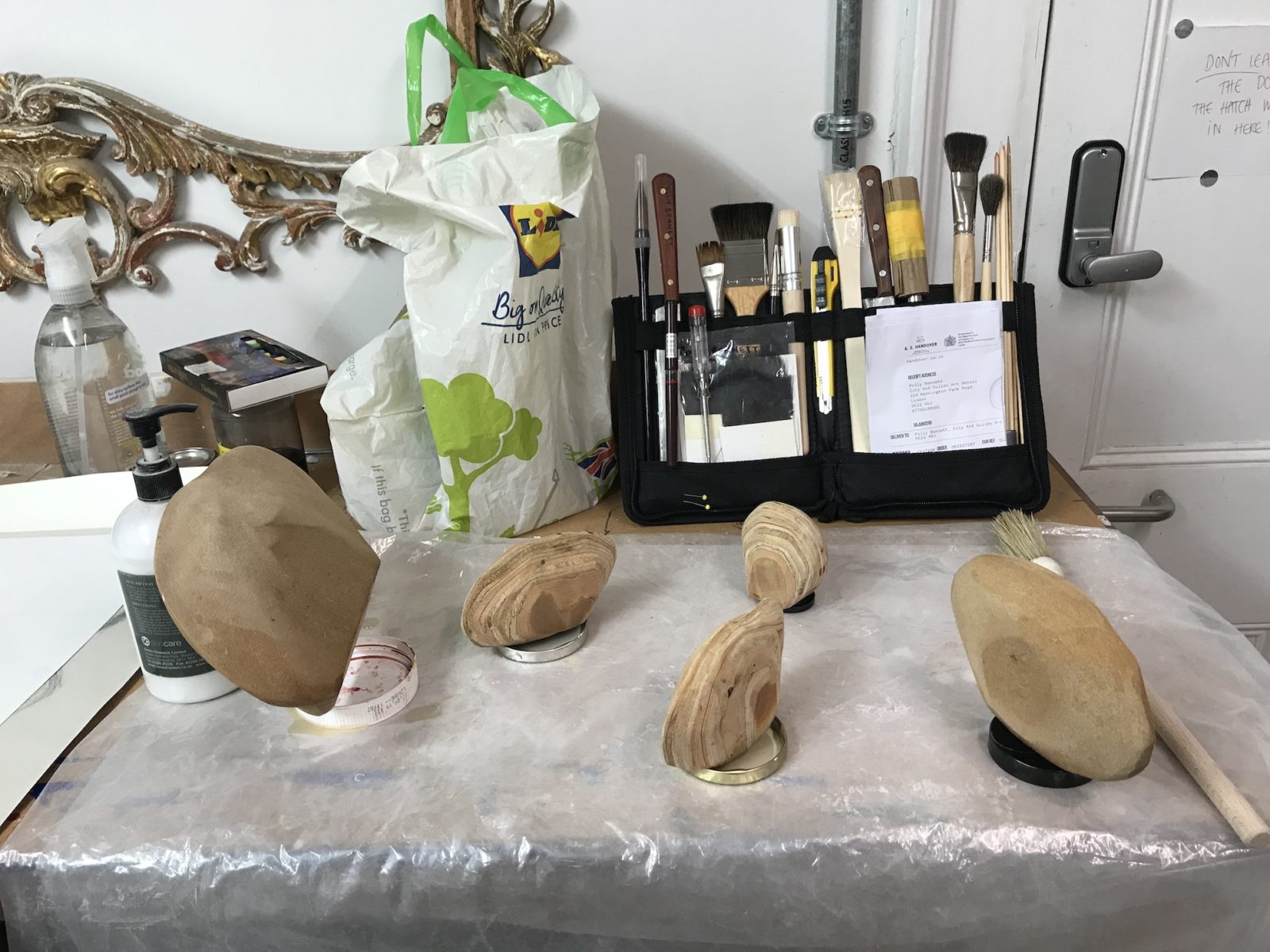
Other experiments with pigment have including making her own inks.
“I had been focusing on minerals, so it made sense to look at organic materials like plants and lichen too; to dry things, crush them up, or extract colour by boiling them up and experiment with which technique creates the best colour. That’s been a lot of fun, and quite science-based. I’m going to be looking in making alcohol inks, because supposedly alcohol inks on gold leaf really come to life, their shimmer is particularly nice. Another reason I wanted to make the inks is that in japanning, to tone gold (to put acrylic on top of gold to give shadow and depth), commonly you would use acrylic, but with such an old craft I want to use more traditional things, inks I’ve made myself, that are from organic matter instead of acrylics; so eventually I wouldn’t have to use acrylics at all for japanning which I quite like.
Everything that you see has colour in it, it’s just finding the right way to extract it.”
You can see Polly’s work at the City & Guilds of London Art School MA degree show, 7-15 September 2019.
